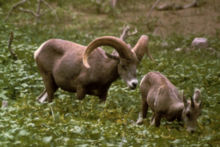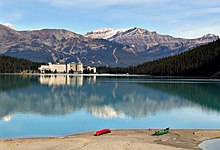Alberta
![]()
This article is about the province of Alberta. For the song Alberta see Leadbelly
Alberta [![]()
![]() æɫˈbɝtə] is the westernmost of Canada's prairie provinces. The capital is Edmonton, and the largest city is Calgary. The province is named after Louise Caroline Alberta, Duchess of Argyll, the fourth daughter of Queen Victoria.
æɫˈbɝtə] is the westernmost of Canada's prairie provinces. The capital is Edmonton, and the largest city is Calgary. The province is named after Louise Caroline Alberta, Duchess of Argyll, the fourth daughter of Queen Victoria.
Alberta's landscape is dominated by the prairies, which extend east to Saskatchewan. The western border of the province is dominated by the foothills of the Rocky Mountains. Alberta has extensive oil reserves and is the richest province in Canada. Other economic factors are grain cultivation and cattle breeding.

The bighorn sheep is very common in the province.

View of Peyto Lake in Banff National Park

View of Lake Louise in Banff National Park
Geography
Alberta covers an area of 661,848 km2, of which 642,317 km2 is land and 19,531 km2 is water.
Location
Alberta borders the U.S. state of Montana to the south, the province of Saskatchewan to the east, the Northwest Territories to the north, and British Columbia to the west.
Waters
With the exception of the southwestern part, Alberta is very rich in water. There are numerous rivers and lakes. The three largest lakes are Lake Athabasca (7,898 km2), the eastern larger part of which lies in the province of Saskatchewan, Lake Claire (1,436 km2) immediately west of Lake Athabasca in Wood-Buffalo National Park, and Lesser Slave Lake (1,168 km2) northwest of Edmonton.
Landscapes
Alberta's capital, Edmonton, is almost at the geographic centre of the province, and most of Alberta's oil is refined here. Southern Alberta, where Calgary is located, is known for its ranching. Much of Alberta's unwooded land is used for grain farming or dairy farming, with ranching and grasslands dominating in the south. Alberta's badlands are in the southeast, where the Red Deer River crosses the flat prairie and farmland, and deep canyons and stunning landscapes can be seen. DinosaurProvincial Park, near Brooks, is the setting for the wasteland terrain, desert flora and remnants of Alberta's past when dinosaurs roamed the landscape.
Ecology
The desertification of the oil shale mining area continues to progress due to high water consumption. In January 2015, in Alberta, fracking triggered a medium earthquake with a magnitude of 4.4 on the Richter scale in a sparsely populated area with the epicentre near the town of Fox Creek, after many smaller quakes. Here the rock had been split with large amounts of water and solvents to a depth of 3000 metres, and the shale sand had been pierced horizontally for up to 2000 metres. It is believed to be the strongest earthquake ever caused by man. The United States Geological Survey confirmed the cause, which is disputed by the companies operating the wells. Gail Atkinson, a specialist in artificially induced earthquakes at Western University in London, Ontario, believes that industrially induced quakes can be more dangerous than natural ones.
While British Columbia requires drilling to cease after earthquakes with a magnitude > 4.0, Alberta has no such law.
Structure
Geographically, Alberta is divided into six regions:
- Alberta's Rockies
- Calgary region
- Central Alberta
- Edmonton Capital Region
- Northern Alberta
- Southern Alberta
Occasionally, the Calgary-Edmonton Corridor is counted as another region. In some cases, the Central Alberta region is included.
For administrative purposes, there is the division into Municipal Districts (see: List of Municipal Districts in Alberta), which in turn are combined into Census Divisions for statistical purposes.
Climate
Since Alberta stretches 1,200 km north-south (and about 600 km east-west), the climate varies considerably between latitudes 49 and 60. It is also influenced by elevation, ranging from about 1,000 metres in the south (Calgary is about 1,000-1,200 metres high and Red Deer is about 850 metres) to 650 metres in the north. The presence of the Rocky Mountains to the west and open prairie to the east also influences the weather. Northern Alberta is mostly covered by taiga and has fewer frost-free days than the south, which has a semi-arid climate. Western Alberta is protected by mountains and enjoys mild temperatures in winter due to Chinook winds. Southeastern Alberta, on the other hand, is generally flat, dry prairie with some hills and extreme temperatures. These range from very cold (-35 °C or lower in winter) to very hot (38 °C or more in summer). Central and parts of northwestern Alberta in the Peace River area are largely Aspen Parklands, a transitional biome between prairie to the south and taiga to the north. After southern Ontario, central Alberta is the region of Canada most likely to experience tornadoes. Thunderstorms are common in summer specifically in central and southern Alberta. The region around the Calgary-Edmonton Corridor is notorious for the highest frequency of hail in Canada.
Generally, Alberta has cold winters with average temperatures ranging from -10 °C in the south to -24 °C in the north. In the south along the foothills of the Rocky Mountains, winter is sometimes interrupted by the Chinook, which causes temperatures to rise to 20 °C or more in a short time. This usually happens in February or March. In summer, average daytime temperatures range up to about 21 °C in the Rocky Mountain valleys and far north, and up to 30 °C in the arid prairies of the southwest. More rain falls in the northern and western parts of the province, and evaporation rates are lower because of cooler summer temperatures. Southern and east-central areas are prone to drought-like conditions; this can be for years at a time, although heavy rainfall can occur in these areas as well. Northern parts of Alberta receive quite a bit of sunshine due to the fairly dry climate; the east-central part of the province bordering Saskatchewan is the sunniest place in Canada, averaging over 2,500 hours of sunshine annually.
Fauna
Alberta's three climatic regions (alpine, forest and prairie) are home to many different species of wildlife. The southern and central prairies were the land of bison. The grass provided food for millions of buffalo. Since the first settlement, the buffalo population has been decimated, but buffalo have rebounded strongly and are thriving on farms and in parks throughout Alberta.
Alberta is home to many large carnivores. Among them are the grizzly and the black bear, which are found in the mountain and forest regions. Smaller representatives of the carnivore dog and cat families are the coyote, wolf, red fox and swift fox, Canadian lynx, bobcat and cougar. The coyote is also found in some parts of large urban centers.
Herbivores are found throughout the province. Moose and deer (both mule deer and white-tailed deer) are found in forested regions, and pronghorn in the prairies of southern Alberta. Bighorn sheep and snow goats live in the Rocky Mountains. Rabbits, tree sparrows, skunks, grey squirrels, and many species of rodents and reptiles live in every region of the province. Alberta is home to only one species of venomous snake, the prairie rattlesnake.
Search within the encyclopedia